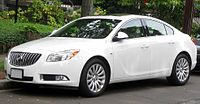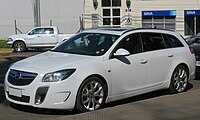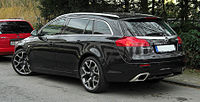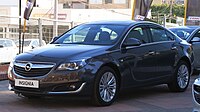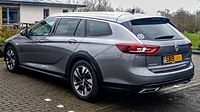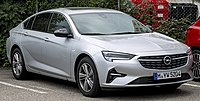Opel Insignia
 From Wikipedia - Reading time: 23 min
From Wikipedia - Reading time: 23 min
| Opel Insignia | |
|---|---|
 | |
| Overview | |
| Manufacturer | Opel[a] |
| Also called |
|
| Production | 2008–2022[1] |
| Model years | 2009–2022 (Europe) 2009–2022 (United Kingdom) 2011–2020 (North America) 2018–present (China) 2018–2020 (Australia & New Zealand) |
| Body and chassis | |
| Class | Large family car (D) |
| Layout | Front-engine, front-wheel-drive or all-wheel-drive |
| Chronology | |
| Predecessor | |
The Opel Insignia is a large family car (D-segment in Europe) developed and produced by the German car manufacturer Opel from 2008 to 2022. Taking its name from a 2003 concept car, the model line serves as the flagship model, slotted above the Astra and Corsa in size. The Insignia serves as the successor to both the Signum and Vectra model lines, replacing both vehicles under a single nameplate.[2] Currently in its second generation, the model line is offered in four-door sedan/saloon body styles, five-door liftback, and as a five-door station wagon/estate.
Sold worldwide, the Insignia is marketed under multiple nameplates. Under Opel tradition, the model line is marketed by Vauxhall in the United Kingdom, taking on the Vauxhall Insignia name. Both generations of the model line have been marketed in Latin America and North America as the Buick Regal[3][4] (sales of the Regal continue in China[5]). GM Australia marketed the second-generation Insignia as the Holden Commodore through 2020 (until discontinuing both the model line and the Holden brand).
The launch vehicle of the GM Epsilon II platform, Opel produces the Opel/Vauxhall Insignia in Adam Opel AG Werk Rüsselsheim in Rüsselsheim, Germany. SAIC-GM produces the Buick Regal in Shanghai, China (exclusively for the Chinese market). In the UK, the Vauxhall Insignia bid farewell as the model was retired in 2022. The Insignia will return with a new look in 2025.
History
[edit]In December 2006, Vauxhall stated they would retire the Vectra nameplate from the previous model. Then General Motors Europe president, Carl-Peter Forster, explained that the all new car would be "a radical departure" from the current model and that the "Vectra" name would be dropped to reflect this change.[6] In late 2007, Vauxhall confirmed that the successor's name would be Insignia.[7]
With the Insignia, Opel planned to regain some of the market share that the executive Omega once occupied during its production.[8]
First generation (G09; 2008)
[edit]| Opel Insignia A | |
|---|---|
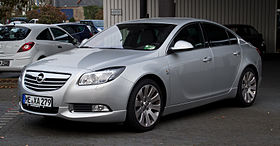 | |
| Overview | |
| Model code | G09 |
| Also called |
|
| Production | October 2008 – April 2017 |
| Assembly |
|
| Designer | Mark Adams and Malcolm Ward[9][10] |
| Body and chassis | |
| Body style | |
| Platform | GM Epsilon II SWB |
| Related | Chevrolet Malibu |
| Powertrain | |
| Engine |
|
| Transmission | 6-speed manual 6-speed automatic |
| Dimensions | |
| Wheelbase | 2,737 mm (107.8 in) |
| Length | 4,830 mm (190.2 in) 4,908 mm (193.2 in) (wagon) |
| Width | 1,856 mm (73.1 in) |
| Height | 1,498 mm (59.0 in) |
| Curb weight | 1,470–1,610 kg (3,240–3,550 lb) |
The Insignia debuted as the Vauxhall Insignia at the 2008 British International Motor Show in London on 23 July.[11] It then went on sale in European dealerships in October 2008 for the 2009 model year as a five-door liftback and five-door estate dubbed Sports Tourer – a departure for Opel which traditionally used the "Caravan" name to denote the estate bodystyle. It was the first production car to be based on the Epsilon II platform, which was also used on other models such as the 2010 Saab 9-5 and the Chevrolet Malibu.
Design wise, the Insignia offers 30 mm (1.2 in) more knee room than the Vectra. The saloon and liftback variants have the same 4.83 m (190.2 in) length, while the estate version is slightly longer at 4.91 m (193.3 in). All three models share the same, 2.73-metre (107.5 in) wheelbase.
The Insignia also marked the debut ofredesigned badges for both the Opel and Vauxhall brands. For Vauxhall, it was the first car to dispense with the characteristic "V" grille that has adorned Vauxhall models since 1994, which had helped differentiate them from the otherwise identical Opel models.
The Insignia was also the first Opel to debut many new and improved safety features, including:
- Improved adaptive Forward Lighting – bi-xenon, gas discharge headlamps with variable light beam distribution in width, direction and range. Advanced Front-Lighting System (AFS), static cornering light, complemented by daytime running lights with LEDs. Sensors and software monitor the surroundings, traffic and weather conditions so that the system can activate the appropriate lighting function.
- Opel Eye – This uses a camera at the top of the windscreen to monitor the area in front of the vehicle. Information from the camera is continuously analysed to identify road markings and traffic signs. Road markings are used as the basis of the first of Opel Eye's two functions: lane departure warning. Traffic signs are recognised and indicated to the driver in the second function: traffic sign memory. At speeds above 60 km/h (37 mph), Opel Eye warns the driver if the car is about to veer inadvertently out of the lane in which it is travelling. The system can detect road markings and, if they are sufficiently distinct, unmarked road edges. The Insignia was the first production car to feature a dual function frontal camera with traffic sign recognition.
A small number (17 examples) of the Insignia OPC were modified by Erich Bitter and sold as the "Bitter Insignia". Only available with the 2.8 Turbo engine, these luxurious derivatives received a new front clip and other exterior modifications, as well as a more luxurious, all-leather interior, where as much plastic as possible was replaced with other materials.[12]
Pre-facelift
[edit]-
Opel Insignia saloon (2008–2013)
-
Opel Insignia liftback/fastback (2008–2013)
-
Opel Insignia Sports Tourer (2008–2013)
-
Interior
Markets
[edit]-
Vauxhall Insignia (United Kingdom; pre facelift)
-
Buick Regal (North America)
-
Chevrolet Vectra (South America)
OPC
[edit]In early 2009, Opel revealed the Insignia OPC, a high performance variant of the Insignia.[13] Like the preceding Vectra OPC, it is powered by a 2.8 litre turbocharged V6 (Manufactured in Melbourne, Australia).[13][14]
The updated engine makes 239 kW (325 PS; 321 hp) and 435 N⋅m (321 lb⋅ft). Of this 435, 400 N⋅m (295 lb⋅ft) are available from 2,000 rpm.[15] It is paired with a six speed manual transmission / six-speed automatic transmission and Saab's (Haldex) active all wheel drive system. The Insignia OPC has a modified MacPherson strut front suspension called HiPerStrut which reduces torque steer.
Also standard is an electronic limited slip differential for the rear wheels and Opel's FlexRide adaptive suspension, which has three settings (OPC, Sport, and Normal). An OPC version of the Insignia Sports Tourer wagon was also unveiled. In April 2011, Opel launched the Insignia OPC Unlimited, with no speed limiter.[16]
-
Opel Insignia OPC Sports Tourer (pre-facelift)
-
Opel Insignia OPC Sports Tourer
-
Opel Insignia OPC (facelift)
-
Holden Insignia VXR sedan (Australia; facelift)
Country Tourer
[edit]The Opel Insignia Country Tourer made its world premiere at the Frankfurt Motor Show in September 2013 as a crossover-styled station wagon.
-
Opel Insignia Country Tourer
-
Opel Insignia Country Tourer
Facelift
[edit]A major facelift was introduced in June 2013, with new exterior and interior styling, new engines, and new safety features. The car officially premiered at the September 2013 Frankfurt Motor Show, before going on sale later in 2013.
The new design includes a newly designed cockpit with a simplified control panel and two eight inch colour displays, a four way infotainment system via new a touchpad in the centre console, an eight-inch touchscreen, steering wheel controls, voice command, radar and camera based driver assistance and safety systems, such as full speed adaptive cruise control and imminent collision braking, rear camera, lane change assistance, blind spot alert, and rear cross traffic alert.
The second generation Insignia was revealed in December 2016, and was reported to be renamed Insignia Grand Sport.
-
Opel Insignia (facelift)
-
Opel Insignia (facelift)
-
Vauxhall Insignia (facelift)
Engines
[edit]2008–2013
[edit]From launch, the Insignia was offered with four petrol engines:
- 1.6 L 115 PS (85 kW; 113 hp); 1.8 L 140 PS (103 kW; 138 hp); 2.0 L Turbo 220 PS (162 kW; 217 hp); 2.8 L V6 with 260 PS (191 kW; 256 hp) –
and three diesel engines (all derived from the Fiat/GM JTD engine), all displacing 2.0 litres:
- 2.0 L 110 PS (81 kW; 108 hp); 2.0 L 130 PS (96 kW; 128 hp); 2.0 L 160 PS (118 kW; 158 hp).
In 2009, a 1.6 L Turbo petrol 180 PS (132 kW; 178 hp), the ecoFLEX diesels, and the OPC versions were introduced.
From September 2010, the 2.0 CDTi diesel engine gained Adaptive 4x4 as an option. A 2.0 BiTurbo CDTI developed with the help of Saab, with 195 PS (143 kW; 192 hp), was expected to begin production in 2010. Due to the sale of Saab, production was delayed until 2012. The BiTurbo CDTI was offered with front- or four-wheel drive. All engines have a six speed manual transmission as standard, with some engines having an automatic transmission as an option.
Since launch, all diesels have improved their emissions. In 2011, some engines gained Start/Stop, all diesel engines have this option, with more petrol engines expected to gain the technology in the future. A 1.4 Turbo 140 PS (103 kW; 138 hp), with S/S as standard, became available - replacing the 1.8 - and the 2.0 Turbo with four-wheel drive was upgraded to 250 PS (184 kW; 247 hp); the front-wheel drive 2.0 Turbo still had 220 PS (162 kW; 217 hp).
In 2009, a new range of ecoFLEX diesel engine offered same amount of power, but less CO2-emission (g/km) and fuel consumption. The 2.0 CDTI ecoFLEX with 130 PS (96 kW; 128 hp) and 160 PS (118 kW; 158 hp) have emission of only 114 CO2-emission (g/km), as well as a version with 2.0 CDTI 4x4. The 195 PS (143 kW; 192 hp) Bi turbo diesel engine has 129 CO2-emission (g/km).
| Petrol engines | |||||||||
|---|---|---|---|---|---|---|---|---|---|
| Model | Engine | Displacement | Power | Torque | Note(s) | Year(s) | |||
| 1.4 Turbo S/S | I4 | 1,364 cc | 140 PS (103 kW; 138 hp) at 4,900–6000 rpm | 200 N⋅m (148 lb⋅ft) at 1850–4,900 rpm | 2011–13 | ||||
| 1.6 VVT | I4 | 1,598 cc | 115 PS (85 kW; 113 hp) at 6,000 rpm | 155 N⋅m (114 lb⋅ft) at 4,000 rpm | 2008–12 | ||||
| 1.6 Turbo | I4 | 1,598 cc | 180 PS (132 kW; 178 hp) at 5,500 rpm | 230 N⋅m (170 lb⋅ft) at 2,200–5,500 rpm | |||||
| 1.8 VVT | I4 | 1,796 cc | 140 PS (103 kW; 138 hp) at 6,300 rpm | 175 N⋅m (129 lb⋅ft) at 3,800 rpm | |||||
| 2.0 Turbo | I4 | 1,998 cc | 220 PS (162 kW; 217 hp) at 5,300 rpm | 350 N⋅m (258 lb⋅ft) at 2,000-4000 rpm | A20NHT (non-flex fuel version of A20NFT) | 2008–13 | |||
| 2.0 Turbo 4x4 | I4 | 1,998 cc | 220 PS (162 kW; 217 hp) at 5,300 rpm | 350 N⋅m (258 lb⋅ft) at 2,000-4000 rpm | 2008–11 | ||||
| 2.0 Turbo 4x4 | I4 | 1,998 cc | 250 PS (184 kW; 247 hp) at 5,300 rpm | 400 N⋅m (295 lb⋅ft) at 2,400–3,600 rpm | 2011–13 | ||||
| 2.8T 4x4 | V6 | 2,792 cc | 260 PS (191 kW; 256 hp) at 5,500 rpm | 350 N⋅m (258 lb⋅ft) at 1,900–4500 rpm | 2008–13 | ||||
| 2.8T 4x4 | V6 | 2,792 cc | 325 PS (239 kW; 321 hp) at 5,500 rpm | 435 N⋅m (321 lb⋅ft) at 5,500 rpm | OPC/VXR | 2009–13 | |||
| Diesel engines | |||||||||
| Model | Engine | Displacement | Power | Torque | Note(s) | Year(s) | |||
| 2.0 CDTI | I4 | 1,956 cc | 110 PS (81 kW; 108 hp) at 4,000 rpm | 260 N⋅m (192 lb⋅ft) at 1,750–2500 rpm | N/A in UK | ||||
| 2.0 CDTI | I4 | 1,956 cc | 130 PS (96 kW; 128 hp) at 4,000 rpm | 300 N⋅m (221 lb⋅ft) at 1,750–2500 rpm | |||||
| 2.0 CDTI | I4 | 1,956 cc | 160 PS (118 kW; 158 hp) at 4,000 rpm | 350 N⋅m (258 lb⋅ft) at 1,750–2500 rpm | |||||
| 2.0 CDTI 4x4 | I4 | 1,956 cc | 160 PS (118 kW; 158 hp) at 4,000 rpm | 350 N⋅m (258 lb⋅ft) at 1,750–2500 rpm | 2010–13 | ||||
| 2.0 CDTI Bi-Turbo | I4 | 1,956 cc | 195 PS (143 kW; 192 hp) at 4,000 rpm | 400 N⋅m (295 lb⋅ft) at 1,750–2500 rpm | 2012–13 | ||||
| 2.0 CDTI Bi-Turbo 4x4 | I4 | 1,956 cc | 195 PS (143 kW; 192 hp) at 4,000 rpm | 400 N⋅m (295 lb⋅ft) at 1,750–2500 rpm | 2012–13 | ||||
2013–2017
[edit]Alongside the facelift of 2013 came a new range of engines – some existing, some tweaked, and some brand new. Diesel engines available at launch include the 2.0 CDTI ecoFLEX (also with Start/Stop), with outputs of 120 PS, 140 PS, and 163 PS and the existing 195 PS BiTurbo. There is also a non ecoFLEX engine with 130 PS which is only available with automatic transmission.
Petrol engines include the existing 1.4 Turbo and 1.8 (only on some markets), and the all new 1.6 SIDI Turbo engine introduced in the Cascada, and new 2.0 SIDI Turbo.
All engines come with a six speed manual gearbox as standard, with a six speed automatic available as an option on the 1.6 and 2.0 SIDI turbo petrol engines, and the 2.0 CDTI 163 PS and 195 PS diesel engines. All petrol and diesel engines have a Start/Stop system except the 2.0 CDTI with 130 PS.
In September 2014, Opel introduced its all new generation of engines – large diesel engine, starting with 2.0 CDTI engine with 170 PS and 400 Nm, which is a part of new strategy in which Opel will introduce 17 new engines in a period from 2014 to 2018. The new engine became available from the end of 2014/beginning of 2015.[17]
| Petrol engines | |||||||||
|---|---|---|---|---|---|---|---|---|---|
| Model | Engine | Displacement | Power | Torque | Note(s) | CO2 (g/km) | Year(s) | ||
| 1.4 Turbo S/S | I4 | 1,362 cc | 140 PS (103 kW; 138 hp) at 4,900–6000 rpm | 200 N⋅m (148 lb⋅ft) at 1850–4,900 rpm | 123 | ||||
| 1.6 SIDI Turbo S/S | I4 | 1,598 cc | 170 PS (125 kW; 168 hp) at 4,250 rpm | 260 N⋅m (192 lb⋅ft) (overboost 280 N⋅m (207 lb⋅ft)) at 1,650–4,250 rpm | 139 | ||||
| 1.8 VVT | I4 | 1,796 cc | 140 PS (103 kW; 138 hp) at 6,300 rpm | 175 N⋅m (129 lb⋅ft) at 3,800 rpm | 164 | ||||
| 2.0 SIDI Turbo S/S | I4 | 1,998 cc | 250 PS (184 kW; 247 hp) at 4,500 rpm | 400 N⋅m (295 lb⋅ft) at 2,000–4,500 rpm | A20NFT (used in Astra J GTC VXR/OPC) | 169 | |||
| Diesel engines | |||||||||
| Model | Engine | Displacement | Power | Torque | Note(s) | CO2 (g/km) | Year(s) | ||
| 1.6 CDTI | I4 | 1,598 cc | 120 PS (88 kW; 118 hp) at 4,000 rpm | 320 N⋅m (236 lb⋅ft) at 2,000 rpm | 109-104 | 2015–17 | |||
| 1.6 CDTI | I4 | 1,598 cc | 136 PS (100 kW; 134 hp) at 4,000 rpm | 320 N⋅m (236 lb⋅ft) at 2,000 rpm | 104-99 | 2015–17 | |||
| 2.0 CDTI ecoFLEX S/S | I4 | 1,956 cc | 120 PS (88 kW; 118 hp) at 4,000 rpm | 300 N⋅m (221 lb⋅ft) (overboost 320 N⋅m (236 lb⋅ft)) at 1,750–2,500 rpm | 99 | 2013–15 | |||
| 2.0 CDTI | I4 | 1,956 cc | 130 PS (96 kW; 128 hp) at 4,000 rpm | 300 N⋅m (221 lb⋅ft) (overboost 320 N⋅m (236 lb⋅ft)) at 1,750–2,500 rpm | Only with AT | 119 | 2013–15 | ||
| 2.0 CDTI ecoFLEX S/S | I4 | 1,956 cc | 140 PS (103 kW; 138 hp) at 4,000 rpm | 350 N⋅m (258 lb⋅ft) (overboost 370 N⋅m (273 lb⋅ft)) at 1,750–2,500 rpm | 99 | 2013–15 | |||
| 2.0 CDTI ecoFLEX S/S | I4 | 1,956 cc | 163 PS (120 kW; 161 hp) at 4,000 rpm | 350 N⋅m (258 lb⋅ft) (overboost 380 N⋅m (280 lb⋅ft)) at 1,750–2,500 rpm | 114 | 2013–15 | |||
| 2.0 CDTI ecoFLEX S/S | I4 | 1,956 cc | 170 PS (125 kW; 168 hp) at 4,000 rpm | 400 N⋅m (295 lb⋅ft) at 1,750–2,500 rpm | 114 | 2014–17 | |||
| 2.0 CDTI Bi-Turbo ecoFLEX S/S | I4 | 1,956 cc | 195 PS (143 kW; 192 hp) at 4,000 rpm | 400 N⋅m (295 lb⋅ft) at 1,750–2,500 rpm | 125 | 2013–15 | |||
Awards
[edit]Since making its début, the Opel Insignia has won more than fifty national and international awards, including 'Best Executive Car' in the United Kingdom and Slovenia, 'Best Family Car' in Ireland twice, and best car for fleet customers in the United Kingdom, Austria, Denmark, and Portugal.[18]
- The Insignia was voted 2009 European Car of the Year.[19][20]
- The Insignia scored a five star rating in EuroNCAP.
- In 2011, German institute DEKRA gave Opel an award for the Insignia as a car with the fewest flaws in its class.[21]
- In 2012, Gesellschaft für Technische Überwachung mbH/Association for Technical Supervision evaluated Opel Insignia as number one in terms of used car quality.[22]
Production and sales
[edit]Production started at the end of 2008 on all major markets in Europe. At launch, the Vauxhall versions were produced in Exclusiv, S, SE, SRi, Elite, and VXR specification levels. It was a popular choice with British buyers, being the nation's ninth best selling car in 2009 – its first full year on sale, outselling its direct competitor the Ford Mondeo, but just falling short of the sales achieved by the more upmarket BMW 3 Series.[23]
At the beginning several trim levels were available, depending on the market: Essentia, Edition, Sport, Cosmo, OPC. Later on others were added, such as the Business edition, Selection, Active, 150 years of Opel, and Innovation.
By August 2011, over 400,000 Insignias had been sold, and on 26 April 2012, the 500,000th Insignia was produced.[24] The last vehicle rolled off the line in April 2017, in time for the release of the Insignia II.
Second generation (Z18; 2017)
[edit]| Opel Insignia B | |
|---|---|
 | |
| Overview | |
| Model code | Z18 |
| Also called | Vauxhall Insignia (United Kingdom) Buick Regal (North America and China) Holden Commodore (ZB) (Australia and New Zealand) |
| Production | 2017–present (China) 2017–2022 (other markets)[25] |
| Model years | 2018–2020 (North America & Oceania) |
| Assembly | Germany: Rüsselsheim China: Shanghai (SAIC-GM) |
| Designer | Niels Loeb[26][27] |
| Body and chassis | |
| Body style | |
| Platform | E2XX platform |
| Related | Chevrolet Malibu Cadillac XT4 |
| Powertrain | |
| Engine | |
| Transmission | |
| Dimensions | |
| Wheelbase | 2,829 mm (111.4 in) |
| Length | 4,897 mm (192.8 in) 4,986 mm (196.3 in) (wagon) |
| Width | 1,864 mm (73.4 in) |
| Height | 1,455 mm (57.3 in) |
| Curb weight | 1,440–1,649 kg (3,175–3,635 lb) |
First leaked to the public in December 2016,[28] the Insignia had its public debut at the International Motor Fair in Belgrade in March 2017. The design took cues from the 2013 Opel Monza Concept. From this point, the traditional four-door notchback saloon version was officially removed from the lineup. The vehicle was officially revealed on 26 June 2017.[clarification needed]
The car is based on a moderately updated version of Epsilon II platform and was wholly developed by General Motors.[29] After the sale of Opel to PSA Group and later Stellantis, it is continued to be produced under license.[30]
Opel dropped the OPC designation for its performance Insignia, instead reverting to their older GSi nameplate, last seen on the second generation Opel Vectra. The GSi nameplate also replaces VXR, on the Vauxhall version of the Insignia. This version of the Insignia is badged as the Holden Commodore ZB in Australia and New Zealand, and as the sixth generation Buick Regal in the Americas and Asia.
After a 2020 facelift, only the 2-liter four-cylinder petrol engine remained available in Europe, while a new 1.5-liter three-cylinder and a 2.0-liter four cylinder diesel replaced the earlier 1.6 and 2.0.
In 2022, Vauxhall discontinued the Insignia from their model range as the result of the brand would moving towards a fully electric lineup and the decline of the D-segment in Europe which also lead to the discontinuation of the Ford Mondeo and the saloon version of the Volkswagen Passat.[31][32]
Opel also ended production of the Opel Insignia in 2022. PSA later reversed course and said that the Insignia nameplate will be resurrected as a crossover SUV in 2024 for both Opel and Vauxhall brands.[33]
Under Stellantis' corporate umbrella, the Citroën C5 X and the DS 9 now cover the D/E segments in Europe.[citation needed]
-
Grand Sport
-
Sports Tourer
-
Vauxhall Insignia (United Kingdom)
-
Vauxhall Insignia Country Tourer (rear)
-
Buick Regal Sportback (North America)
-
Interior
GSi
[edit]-
Opel Insignia GSi (pre-facelift)
-
Opel Insignia GSi (pre-facelift)
-
Buick Regal GS (pre-facelift)
Facelift (2020)
[edit]-
Opel Insignia (facelift)
-
Vauxhall Insignia (facelift)
-
Buick Regal GS (facelift)
Engines
[edit]| Petrol engines | |||||||||
|---|---|---|---|---|---|---|---|---|---|
| Model | Engine | Displacement | Power | Torque | Note(s) | CO2 (g/km) | Year(s) | ||
| 1.5 SIDI Turbo S/S | I4 | 1,490 cc | 140 PS (103 kW; 138 hp) at 5,600 rpm | 250 N⋅m (184 lb⋅ft) at 2,000-4,500 rpm | 133 | 2017– | |||
| 1.5 SIDI Turbo S/S | I4 | 1,490 cc | 165 PS (121 kW; 163 hp) at 5,600 rpm | 250 N⋅m (184 lb⋅ft) at 2,000–4,500 rpm | 136 | 2017– | |||
| 2.0 SIDI Turbo S/S | I4 | 1,998 cc | 260 PS (191 kW; 256 hp) at 5,300 rpm | 400 N⋅m (295 lb⋅ft) at 2,500–4,000 rpm | Holden Commodores only boast 350Nm, in order to ensure V6 remains flagship engine | 197 | 2017– | ||
| 3.6 SIDI LGX | V6 | 3,564 cc | 320 PS (235 kW; 316 hp) at 6,800 rpm | 381 N⋅m (281 lb⋅ft) at 5,200 rpm | Available only on Holden Commodore (all versions) and Buick Regal GS | 215 | 2018– | ||
| Diesel engines | |||||||||
| Model | Engine | Displacement | Power | Torque | Note(s) | CO2 (g/km) | Year(s) | ||
| 1.5 CDTI S/S | I3 | 1,496 cc | 122 PS (90 kW; 120 hp) at 3,500 rpm | 300 N⋅m (221 lb⋅ft) at 1,750-2,000 rpm | 105 | 2020– | |||
| 1.6 CDTI S/S | I4 | 1,598 cc | 110 PS (81 kW; 108 hp) at 3,500 rpm | 300 N⋅m (221 lb⋅ft) at 1,750-2,000 rpm | 105 | 2017– | |||
| 1.6 CDTI S/S | I4 | 1,598 cc | 136 PS (100 kW; 134 hp) at 3,500-4,000 rpm | 320 N⋅m (236 lb⋅ft) at 2,000-2,250 rpm | 114 | 2017– | |||
| 2.0 CDTI S/S | I4 | 1,956 cc | 170 PS (125 kW; 168 hp) at 3,750 rpm | 400 N⋅m (295 lb⋅ft) at 1,750–2,500 rpm | 136 | 2017– | |||
| 2.0 CDTI BiTurbo S/S 4x4 | I4 | 1,956 cc | 210 PS (154 kW; 207 hp) at 4,000 rpm | 480 N⋅m (354 lb⋅ft) at TBC | 190 | 2017– | |||
Holden Commodore (ZB)
[edit]
In 2017, Holden announced that the Commodore would end production in Australia and confirmed that the Commodore badge would be inherited by its replacement - now fully imported. This decision was made on the basis of a survey revealing that a majority of customers were in favour of retaining the long-standing Australian badge introduced in 1978.
The ZB Commodore was revealed on the 6 December 2016 as a rebadged version of the Opel Insignia B. The ZB Commodore was offered with four or six-cylinder engine options, coupled with front-wheel drive (FWD) or all-wheel drive. This was a major departure from the V8 and rear wheel drive variants available on the previous generation Commodore.
There was significant controversy regarding Holden's decision to retain the Commodore name for the 2018 model, despite it being dimensionally smaller than its predecessor, lacking a V8 engine option, and switching from a RWD to a FWD drivetrain. Whilst the decision has been considered to be a safe choice in order to preserve sales, the retention of the Commodore name has been critiqued for Holden missing the opportunity to rebrand its sedan range and push its offering into the more lucrative semi-premium end of the market.
As of April 2018[update], the ZB Commodore has the lowest resale value as a proportion of new price of any car on the Australian market.[34]
Due to slow sales and Holden's interest in other vehicle segments, it was announced on 10 December 2019 that the ZB Commodore would be discontinued in early 2020, shortly before GM's decision to retire the Holden brand entirely.[35][36]
Buick Regal
[edit]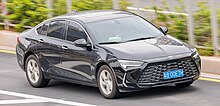
In July 2023, the Buick Regal was facelifted exclusively for the Chinese market, featuring the updated triple shield logo among the changes.[37][38]
Motorsport
[edit]
The Thorney Motorsport team first ran a Vauxhall Insignia VXR in the last round of the 2011 British Touring Car Championship to prepare a two car team for the season of 2012.[39]
Only one car was run in four rounds – 1 and 2 driven by John Thorne, and 6 and 9 driven by Tony Gilham. Tony's Team HARD bought the two Insignias from Thorney Motorsport,[40] and raced one of them himself in the last round of the 2012 season.
Driving both cars for the season of 2013 were James Cole and Jack Goff, running under the RCIB Insurance Racing team name. RCIB Insurance Racing/Team Hard sold the cars to BMR for the 2014 BTCC season, and would be driven by Jack Goff and Warren Scott. The Insignia was not as competitive as hoped and the cars were replaced mid season with Volkswagen CCs.
Other rebranding
[edit]In Chile, the Insignia was introduced in 2008 as the Chevrolet Vectra.[41] In 2013, the model line dropped its Chevrolet name, adopting the Opel Insignia nameplate.
In August 2012, the Opel Insignia was introduced to Australia; following the 2013 withdrawal of Opel from Australia by GM, the model line was dropped from the market.[42][43] For 2015, the Insignia returned to Australia (and for the first time, New Zealand) under the Holden marque, slotted slightly under the Commodore range in market position.
2003 Insignia concept
[edit]| 2003 Insignia Concept | |
|---|---|
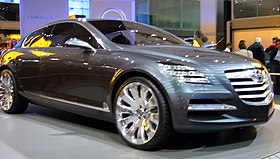 | |
| Overview | |
| Manufacturer | Opel |
| Production | 2003 (Concept car) |
| Designer |
|
| Body and chassis | |
| Class | Luxury car |
| Body style | 5-door liftback/fastback |
| Layout | FR layout[44] |
| Platform | GM V platform[44] |
| Powertrain | |
| Engine | 5.7 L LS1 V8 |
| Transmission | 7-speed automatic |
| Dimensions | |
| Wheelbase | 2,915 mm (114.8 in) |
| Length | 4,803 mm (189.1 in) |
| Width | 1,914 mm (75.4 in) |
| Height | 1,414 mm (55.7 in) |
| Chronology | |
| Successor | Buick Avenir |
The Opel Insignia nameplate saw its first use on a 2003 concept car. For the 2003 Frankfurt Motor Show,[45] Opel debuted a concept car previewing a potential mid-2000s full-size luxury car (F-segment) for the brand.[46]
Derived from the rear-wheel drive GM V platform used by the VY Holden Commodore and Statesman,[47] the Opel Insignia concept vehicle was styled as a fastback 5-door liftback.[48] The engine was sourced from the Chevrolet Corvette C5, pairing a 344 hp LS1 V8 with an all-new 7-speed automatic transmission.[47]
The Insignia debuted several notable features, including a reconfigurable rear seat (changing between 5-passenger seating and a 2+2 layout with a rear center console[45][47]), LED headlamps (powered by 405 LEDs[45]), a reconfigurable dashboard and center console (with air-conditioned storage and humidor[47]). The rear sliding doors were fitted with pantographic hinges, allowing for the deletion of external guide rails.[46]
Intended primarily as a debut of the design language of the Opel brand for the mid-2000s, the Insignia was not officially intended for production.[46] In the beginning of 2005, Opel stated that it would not build a production version of the vehicle, claiming it would be too heavy and expensive. Elements of the Insignia concept design were eventually adopted by other GM vehicles, including the 2015 Buick Avenir concept (sharing a similar fastback/4-door coupe configuration) and the 2008-2017 Opel Insignia/Buick Regal (rear fascia) and the 2010-2016 Buick LaCrosse (roofline); its liftback configuration was adopted by the 2018 Insignia/Regal/Commodore.
-
Opel Insignia Concept at the 2003 Frankfurt Motor Show
-
Rear sliding doors
-
Rear view
Notes
[edit]- ^
- General Motors (2008–2017)
- PSA Group (2017–2021)
- Stellantis (2021–present)
References
[edit]- ^ "Opel Insignia: Aus für die Mittelklasse schon 2022".
- ^ "New Opel Insignia: New Name for a New Era". General Motors. 29 November 2007. Archived from the original on 30 March 2008. Retrieved 2 April 2008.
- ^ Aziz, Nick (20 July 2009). "Confirmed: Buick Regal coming to America in late 2010". Leftlane. Archived from the original on 5 November 2011. Retrieved 21 August 2009.
- ^ "Opel Insignia" (in Spanish). Opel Chile. 12 January 2012. Retrieved 12 January 2012.
- ^ Aziz, Nick (5 November 2008). "2010 Buick Regal: Insignia-based luxury sedan for China revealed". Leftlane. Archived from the original on 15 October 2018. Retrieved 21 August 2009.
- ^ "Vauxhall to ditch Vectra name". whatcar.com. 11 December 2006. Retrieved 11 June 2015.
- ^ "Goodbye Vauxhall Vectra, hello Insignia". whatcar.com. 29 November 2007. Retrieved 11 June 2015.
- ^ "Opel aims Insignia at Omega buyers". Automotive News Europe. Wim Oude Weernink. Retrieved 25 January 2023.
- ^ "Malcolm Ward Appointed Director of Exterior Design". Theautochannel.com. 22 April 2009. Retrieved 14 December 2013.
- ^ "Media". www.vauxhall.co.uk. Retrieved 5 March 2013.[dead link]
- ^ "London show: Vauxhall Insignia". Autocar. 22 July 2008. Retrieved 2 August 2008.
- ^ Maltzan, Jörg (2 July 2010). "Der Kohlenpott-Maserati" [Coal country Maserati]. Auto Bild (in German). Axel Springer. Archived from the original on 4 December 2017.
- ^ a b Pettendy, Marton (16 April 2009). "First look: HSV's turbocharged Insignia mid-sizer". GoAuto. Archived from the original on 4 March 2016. Retrieved 8 October 2009.
- ^ Torr, Feann (9 August 2005). "Opel Vectra OPC: First Look". WebWombat. Retrieved 8 October 2009.
- ^ Miercuri, Publicat (15 July 2009). "Cireasa de pe tort". AutoMarket (in Romanian). Retrieved 8 October 2009.
- ^ "New Opel Insignia OPC Unlimited Edition Ditches Speed Limiter topping out at 270km/h". Carscoops. 15 April 2011. Retrieved 14 December 2013.
- ^ "All-new Opel 2.0 CDTI: New Generation Large Diesel Debuts in Paris". Media Opel. 10 September 2014. Retrieved 14 November 2014.
- ^ "Happy Birthday Opel Insignia – Europe's Shooting Star in 2009". bloggersbase.com. Archived from the original on 15 November 2009. Retrieved 1 May 2010.
- ^ "Rewind to 2009: Vauxhall Insignia". Quicks. Archived from the original on 4 February 2014. Retrieved 25 February 2014.
- ^ Tan, Paul (17 November 2008). "Vauxhall Insignia wins 2009 Car of the Year award". Retrieved 17 November 2008.
- ^ "DEKRA Faults Report 2011: Opel Insignia Gets Top Marks for Quality". Retrieved 15 December 2010.
- ^ "GTÜ Used Car Report – Opel Insignia is Again Number One". Archived from the original on 4 March 2016. Retrieved 17 September 2012.
- ^ "Ford Fiesta is top in 09". Car Dealer Magazine. 8 January 2010. Archived from the original on 21 May 2010. Retrieved 16 January 2010.
- ^ "The 500.000th Opel Insignia Leaves The Rüsselsheim Plant". scoopcar.com. Archived from the original on 14 December 2013. Retrieved 26 April 2012.
- ^ "Opel Insignia Production To End This Year: Official".
- ^ US D847028, Loeb, Niels, "Vehicle, toy replica, and/or other replica", published 2019-04-30, assigned to GM Global Technology Operations LLC
- ^ US D846448, Loeb, Niels, "Vehicle, toy replica, and/or other replica", published 2019-04-23, assigned to GM Global Technology Operations LLC
- ^ "2017 Opel Insignia official reveal hits tomorrow".
- ^ "2017 Vauxhall Insignia Grand Sport to be brand's flagship model (7 November 2016)". Autocar. Retrieved 16 April 2021.
- ^ Niculescu, Aurel (15 September 2020). "Vestigial 2021 Opel Insignia Now in Production, Prices Kick Off at €29,965". autoevolution. Retrieved 13 October 2021.
- ^ "Vauxhall drops Insignia from UK line-up". Fleet News UK.
- ^ "RIP: the Vauxhall Insignia is dead". Top Gear. 16 May 2022.
- ^ "Vauxhall Insignia to be reborn as SUV in 2024". Auto Express.
- ^ Mckinnon, Bill (14 April 2018). "Holden ZB Commodore RS V6 Liftback review: A Holden in name only". The Australian. Retrieved 25 April 2018.
- ^ Bijoux, Nile (10 December 2019). "Holden just killed the Commodore". Autocar. New Zealand. Retrieved 10 December 2019.
- ^ "Holden axes Commodore range to focus on SUVs and utes as sedan sales dwindle". Australia: ABC News. 10 December 2019. Retrieved 10 December 2019.
- ^ Gauthier, Michael (27 July 2023). "2024 Buick Regal Debuts In China With Turbo Power And Questionable Looks". Carscoops.
- ^ "2024 Buick Regal Goes Official, Tries To Teach An Old Dog New Tricks". Motor1.com. 28 July 2023.
- ^ Turner, Kevin (11 April 2011). "New BTCC team to run Insignias". Autosport. Retrieved 12 April 2011.
- ^ Chalcraft, Jodie (16 October 2012). "Two Vauxhall Insignias for Team Hard in 2013". Btcccrazy.co.uk. Retrieved 14 December 2013.
- ^ "Multiplicación de novedades". El Mercurio (in Spanish). 18 October 2008. Archived from the original on 26 February 2009. Retrieved 4 November 2008.
- ^ Flynn, Malcolm (1 August 2012). "2013 Opel Insignia On Sale In Australia". Themotorreport.com.au. Retrieved 14 December 2013.
- ^ Dowling, Joshua (2 August 2013). "Opel abandons Australian arm after less than a year after poor sales". News.com.au. Archived from the original on 5 November 2013. Retrieved 14 December 2013.
- ^ a b "Concept We Forgot: 2003 Opel Insignia". motor1.com. Retrieved 15 February 2022.
- ^ a b c "Opel Insignia : Concept Cars". Diseno-art.com. Retrieved 14 December 2013.
- ^ a b c "Opel Insignia Concept". Supercars.net. 1 March 2004. Retrieved 27 January 2012.
- ^ a b c d "Concept We Forgot: 2003 Opel Insignia". Motor1.com. Retrieved 28 February 2022.
- ^ "Opel Insignia Concept". 14 April 2022.
 KSF
KSF




